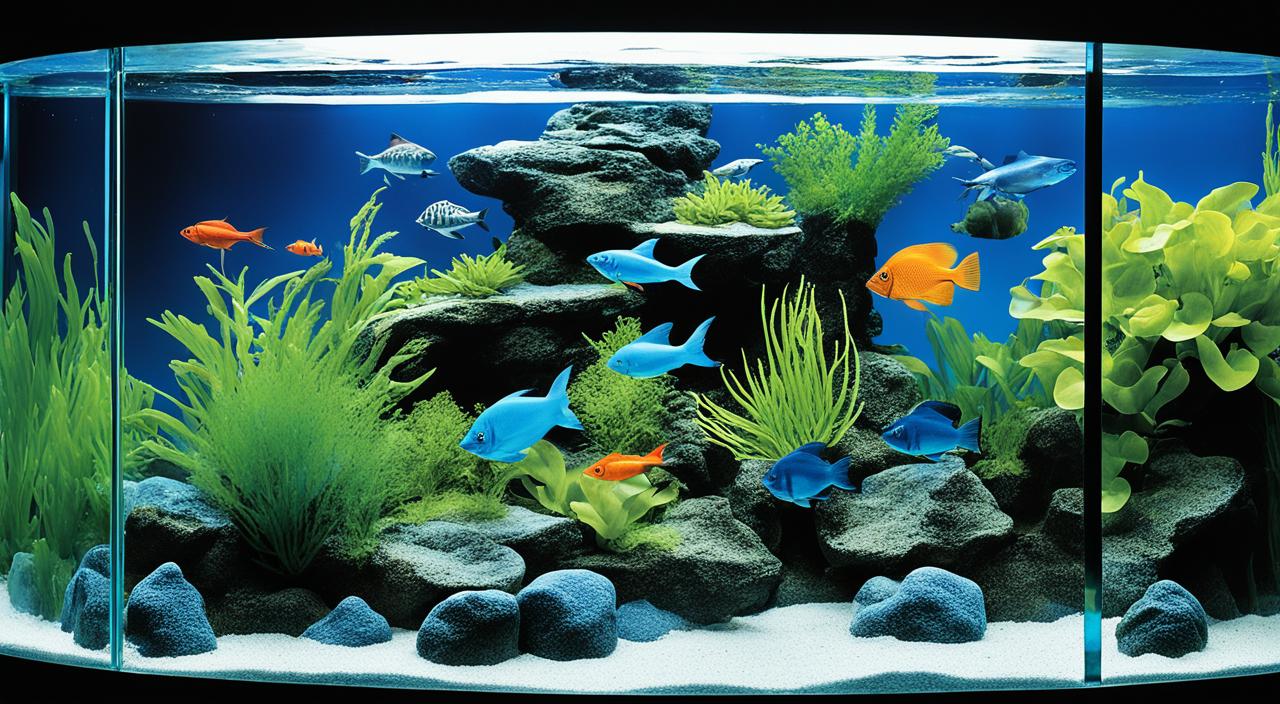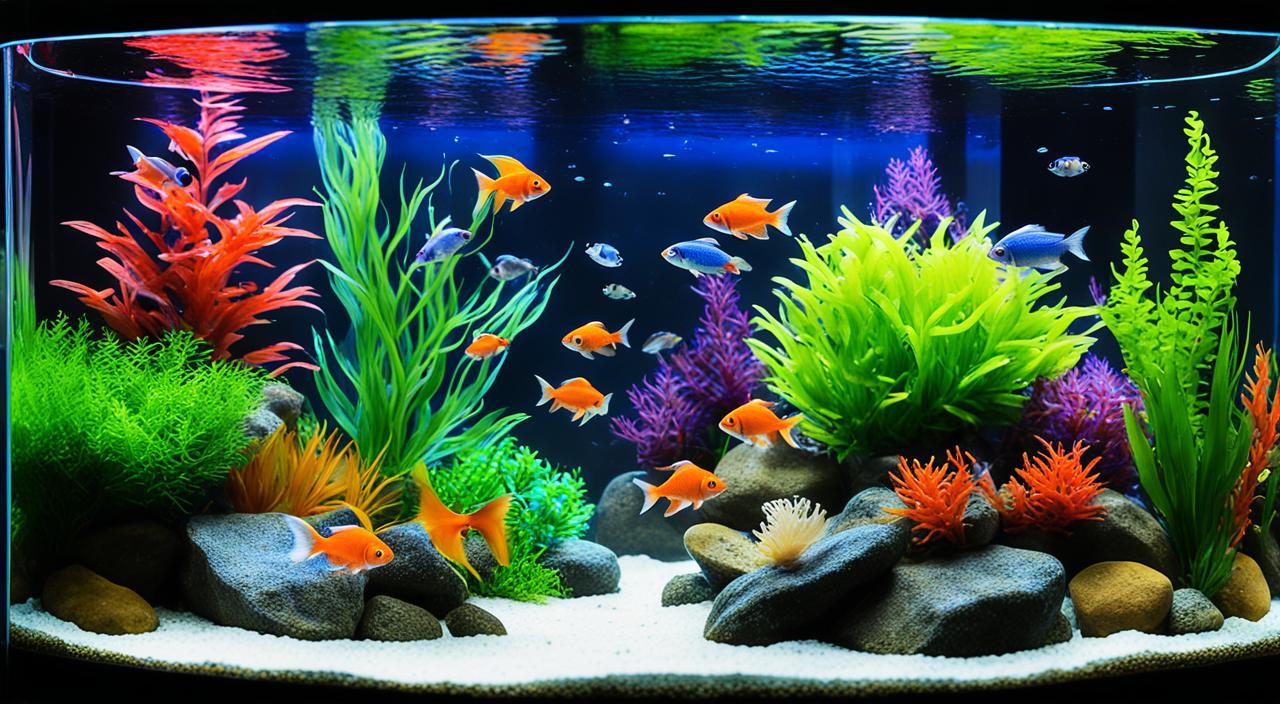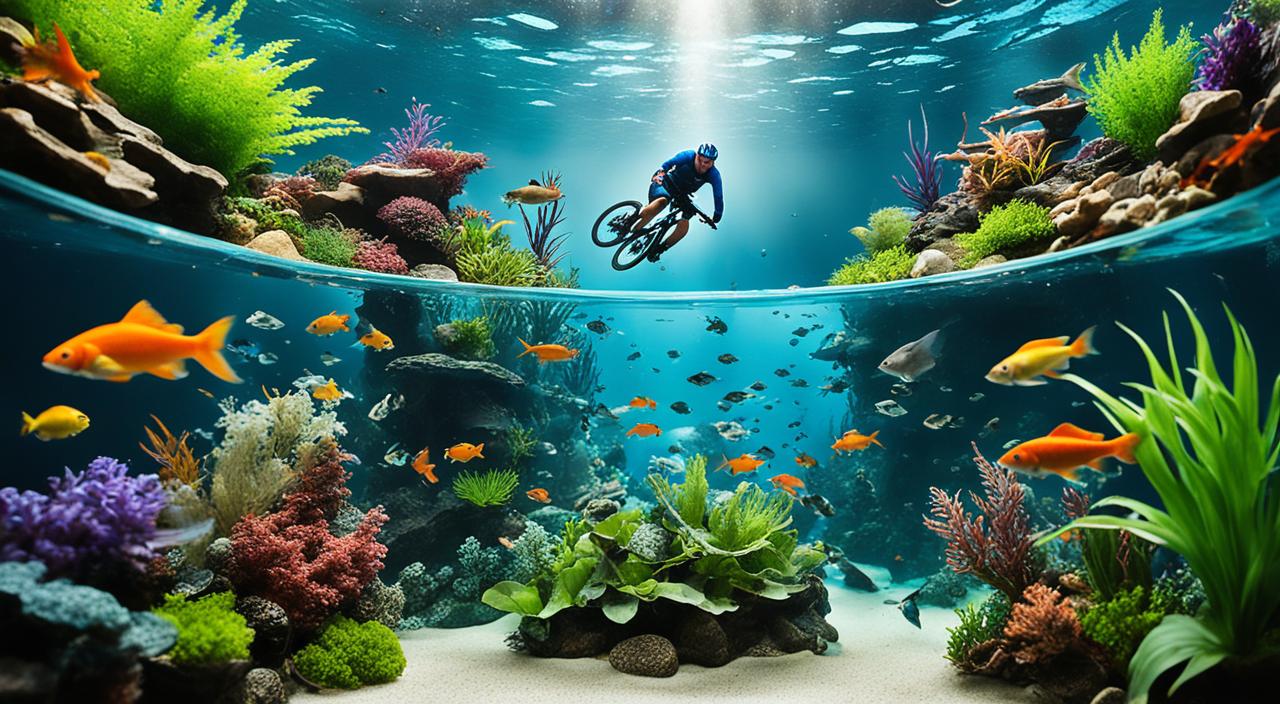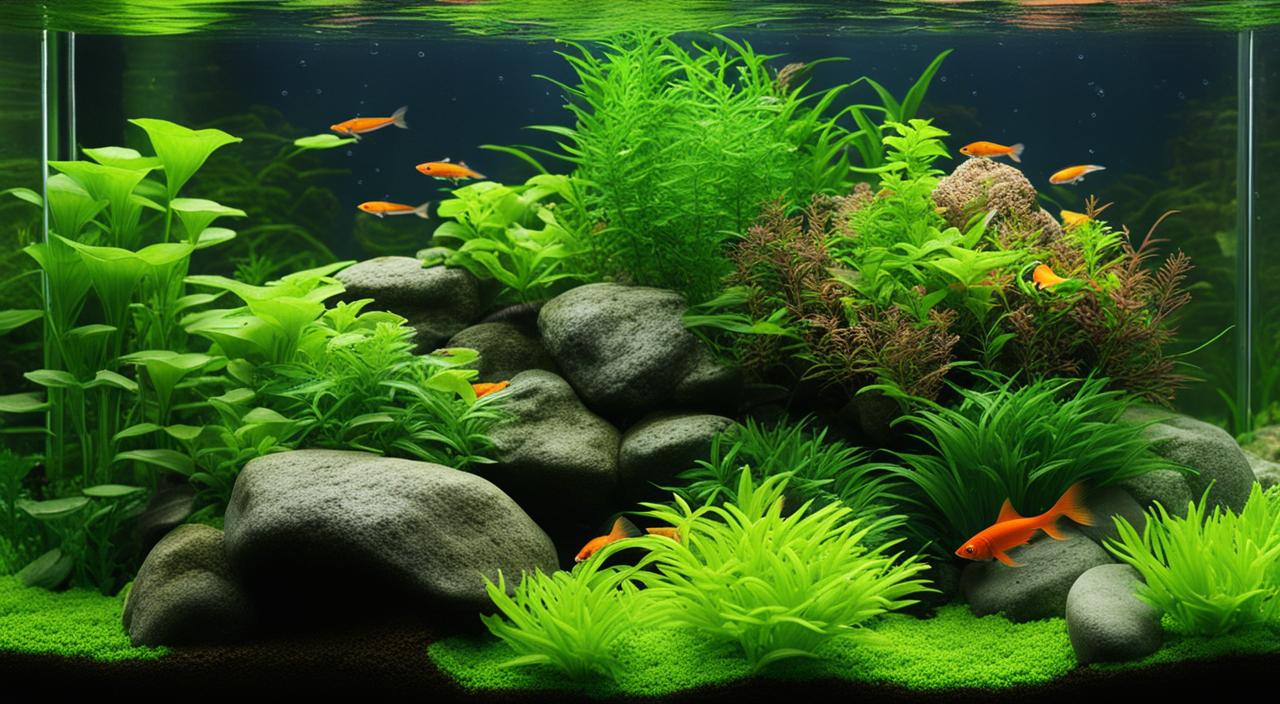When setting up a new aquarium, it’s crucial to understand the cycling process and the importance of regular water changes. These two elements are vital in creating a healthy and safe environment for your fish to thrive. So, let’s delve into the details of aquarium cycling methods and the significance of water changes in maintaining optimal water quality.
Key Takeaways:
- Cycling is crucial for establishing a biologically safe environment for fish in a new aquarium.
- By introducing nitrifying bacteria, the cycling process regulates the nitrogen cycle, converting harmful substances like ammonia into less toxic forms.
- An adequately cycled aquarium ensures the development of a fully functioning biological filter, preventing toxicity issues and promoting fish health in the long run.
- Regular water changes during the cycling process help maintain low levels of toxins, such as ammonia and nitrite, promoting a healthier environment for fish.
- The timeline for aquarium cycling typically takes four to eight weeks, depending on various factors.
- There are two main methods of aquarium cycling: fish-in and fishless cycling, each with advantages and considerations.
Importance of the Cycling Process in an Aquarium
The cycling process is essential for maintaining a healthy and thriving aquarium. It plays a crucial role in establishing a balanced ecosystem for your fish. Understanding the importance of cycling a fish tank will help create a safe and stable environment for your aquatic pets.
When you set up a new aquarium, it is not immediately ready to support fish. The water may contain high levels of ammonia, which is toxic to fish. This is where the cycling process comes into play. It allows beneficial bacteria to grow and establish themselves in the aquarium, creating a natural filtration system known as the biological filter.
Why is the Biological Filter Important?
The biological filter is responsible for removing harmful substances, such as ammonia and nitrite, from the water. These substances are produced as a result of fish waste and decomposing organic matter in the tank. Without a fully functioning biological filter, these toxins can accumulate and reach dangerous levels, putting your fish at risk of stress and illness.
During the cycling process, nitrifying bacteria colonize the aquarium’s surfaces, such as the substrate, decorations, and filter media. These bacteria convert ammonia into nitrite, which is still toxic to fish but less harmful. Another group of bacteria then converts nitrite into nitrate, which is relatively harmless in low concentrations and can be removed through regular water changes.
By cycling an aquarium properly, you ensure that the tank is biologically prepared to handle the waste produced by the fish. This prevents a condition known as “New Tank Syndrome.” When a tank has not been cycled, the sudden introduction of fish can lead to a rapid rise in ammonia levels, causing stress and potential harm to the fish. Cycling the tank in advance establishes a stable environment that promotes the long-term health and well-being of your fish.
It’s important to understand that the cycling process takes time. It typically takes four to eight weeks for the beneficial bacteria to fully establish in the aquarium. During this time, you need to monitor ammonia, nitrite, and nitrate levels regularly to ensure they are within acceptable ranges. Once ammonia and nitrite levels drop to zero, and nitrate levels are present, your tank has successfully cycled and is ready for fish.
The Benefits of Properly Cycling an Aquarium
The benefits of properly cycling an aquarium are numerous:
- Creates a healthy and stable environment for fish
- Reduces the risk of fish stress and illness
- Maintains water parameters within safe levels
- Promotes the growth of beneficial bacteria
- Prevents “New Tank Syndrome” when introducing fish
- Ensures the long-term health and well-being of your fish
The cycling process is a fundamental step in setting up and maintaining a successful aquarium. By providing a suitable habitat for your fish, you can enjoy a beautiful and thriving aquatic environment. Remember to be patient and monitor water parameters throughout the cycling process to ensure a smooth transition for your fish.
The Role of Water Changes in a Cycling Aquarium
Contrary to some misconceptions, performing regular water changes during the cycling process is highly beneficial. Water changes play a crucial role in maintaining a healthy and stable environment for the fish in your aquarium. They help maintain low levels of toxins like ammonia and nitrite, which can be harmful to your fish.
During the cycling process, nitrifying bacteria break down the toxic ammonia and convert it into less harmful nitrite. However, both ammonia and nitrite can still pose a risk to your fish, and that is where water changes come in.
By removing a small portion of the water in your fish tank and replacing it with clean, treated water, you can help keep ammonia and nitrite levels low. This not only reduces the stress on your fish but also promotes their overall health and well-being.
In addition to reducing toxin levels, water changes also provide oxygen to the nitrifying bacteria present in the biological filter. These bacteria are crucial for the cycling process as they help break down ammonia and nitrite. Adequate oxygen levels are essential for their survival and ability to perform their necessary functions effectively.
To ensure proper water changes, follow these steps:
- Prepare the clean water by using a dechlorinator or water conditioner to remove any chlorine or chloramines.
- Using a siphon or a vacuum, remove approximately 20% of the water from your fish tank.
- Gently pour the treated water back into the tank, being careful not to disturb the substrate or decorations.
It is important to note that the frequency and amount of water changes may vary depending on the size of your tank, the number of fish, and water quality parameters. Regular testing of ammonia, nitrite, nitrate levels, and pH can help you determine the appropriate schedule for water changes.
Remember, water changes are an essential part of maintaining a healthy and thriving aquarium. By regularly performing water changes, you can help keep ammonia and nitrite levels in check, promote the growth of beneficial bacteria, and provide a clean and safe environment for your fish.
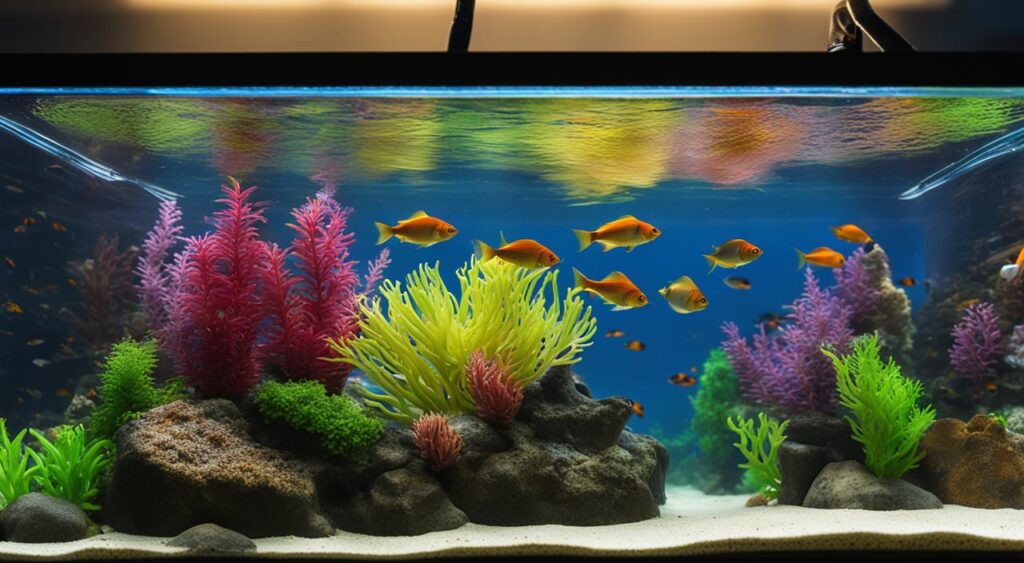
| Benefits of Water Changes in a Cycling Aquarium | Steps for Performing Water Changes |
|---|---|
|
|
How to Cycle an Aquarium and the Timeline
Cycling an aquarium is an essential step in creating a healthy and thriving environment for your fish. The process typically takes four to eight weeks, although the timeline can vary based on factors such as tank size, water temperature, and pH levels.
To begin the cycling process, it’s important to set up the tank’s components, including pumps, filters, and substrate. These elements provide the foundation for a balanced ecosystem.
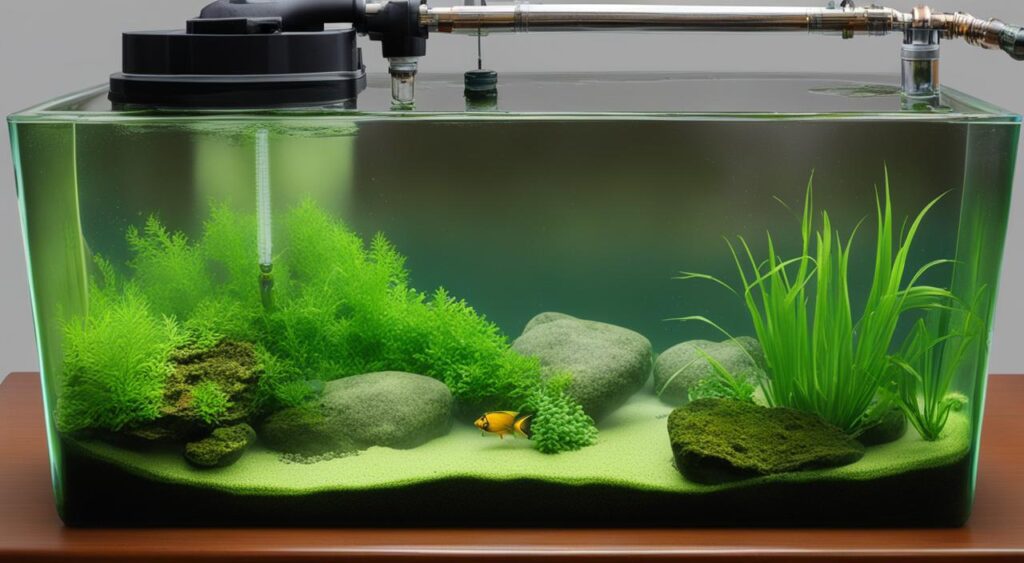
Once the tank is set up, you’ll need to introduce ammonia to kickstart the growth of beneficial nitrifying bacteria. This can be done by using fish food or a pure ammonia source. The bacteria will convert the ammonia into nitrite, and then further into less harmful nitrate.
Regular testing of water parameters, including ammonia, nitrite, and nitrate levels, is crucial to monitor the progress of the cycle. Testing kits are available at most pet stores and will help you ensure that the tank is progressing as it should.
As the cycle progresses, you may notice ammonia and nitrite levels spike before gradually decreasing. This is normal and indicates that the bacteria are establishing themselves and performing their essential role in breaking down harmful substances.
When both ammonia and nitrite levels drop consistently to zero and nitrates are being produced, the tank has successfully cycled. At this point, the tank is ready to house fish, as the environment is stable and capable of supporting aquatic life.
It’s important to note that rushing the cycling process or adding fish before the cycle is complete can lead to stress, illness, and potential harm to the fish. Patience and careful monitoring are key to creating a healthy and thriving aquarium.
By following the proper cycling process and timeline, you can establish a balanced ecosystem that provides a safe and optimal environment for your fish to thrive.
Fish-In vs. Fishless Cycling: Which Method to Choose
When it comes to cycling an aquarium, there are two main methods to consider: fish-in and fishless cycling. Let’s explore the advantages and considerations of each to help you make an informed decision.
Fish-In Cycling:
In fish-in cycling, you introduce fish to your tank while it is in the cycling process. The waste produced by the fish provides the necessary ammonia for the growth of nitrifying bacteria. While this method may seem more natural, it can be stressful for the fish, as the toxin levels may fluctuate during the cycling process.
To ensure the well-being of the fish, closely monitoring the water parameters and performing frequent water changes is essential. This helps maintain acceptable toxin levels and creates a safer environment for the fish to thrive.
Fishless Cycling:
Fishless cycling, on the other hand, offers a more controlled and humane approach. This method involves adding a source of pure ammonia or using fish food to generate ammonia without live fish. By doing so, you provide the necessary ammonia for the growth of nitrifying bacteria without subjecting fish to potential stress.
Fishless cycling allows for better control of water parameters throughout the process, minimizing the risk of toxin spikes. It is considered an excellent choice, especially for beginners who want to ensure the health and well-being of their fish.
In conclusion, both fish-in and fishless cycling methods have their pros and cons. Ultimately, your choice will depend on your preferences and priorities. While fish-in cycling may seem more natural, fishless cycling offers better control and reduces the risk of harm to your fish. Regardless of the method you choose, remember that patience is key in the cycling process to establish a healthy and balanced aquarium ecosystem.
FAQ
What is the purpose of the cycling process in an aquarium?
The cycling process is crucial for establishing a biologically safe environment for fish in a new aquarium. It involves introducing nitrifying bacteria to regulate the nitrogen cycle, which helps break down harmful substances like ammonia and nitrite.
Why is water changes important during the cycling process?
Water changes are highly beneficial during the cycling process as they help maintain low levels of toxins like ammonia and nitrite, which can be harmful to fish. Regular water changes promote a healthier environment and provide oxygen to the beneficial bacteria in the biological filter.
How long does it take to cycle an aquarium?
The cycling process typically takes four to eight weeks, although the timeline can vary depending on factors such as tank size, water temperature, and pH levels.
What are the methods of cycling an aquarium?
There are two main methods of cycling an aquarium: fish-in cycling and fishless cycling. Fish-in cycling involves adding fish to the tank while it is cycling, whereas fishless cycling involves using a source of pure ammonia or fish food to generate ammonia without live fish.
Which method of cycling is recommended for beginners?
Fishless cycling is generally recommended for beginners and those who want to ensure the health and well-being of their fish. This method is considered more humane and allows for better control of water parameters during the cycling process.

